Menus
- Water Buffalo in Jewel Gray Metallic
- For the quick euro: botch on a grand scale
- Carburetor battery looked bad
- The order was: “Make them gray for me!”
- Documentation for the restoration of the Suzuki GT 750
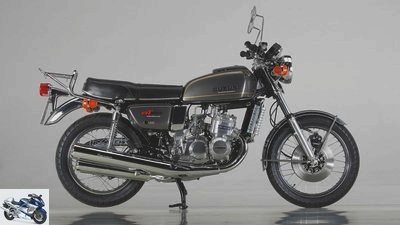
bilski-fotografie.de
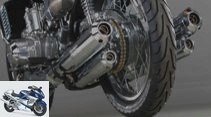
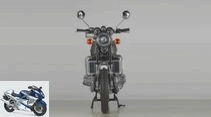
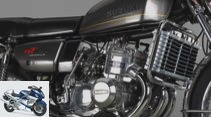
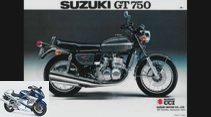
18th photos
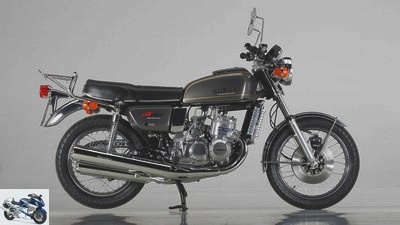
bilski-fotografie.de
1/18
Suzuki GT 750 A in the studio.
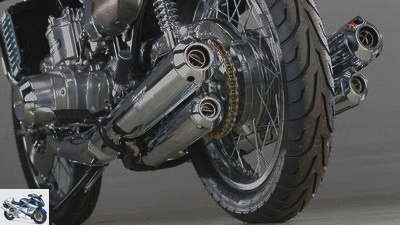
bilski-fotografie.de
2/18
Made of chrome-plated sheet steel: The three-in-four replica exhaust system by Delkevic from England, which is true to the original up to the embossed lettering. The removable inserts are made of galvanized sheet metal.
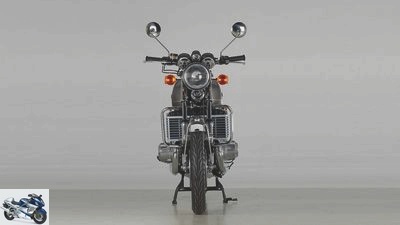
bilski-fotografie.de
3/18
The unmistakable front view of the water buffalo is characterized by the large cooler
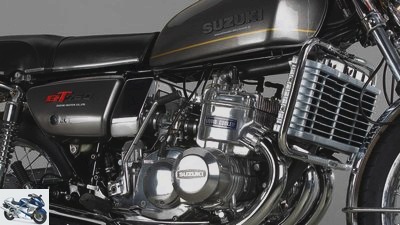
bilski-fotografie.de
4/18
The shiny motor housing is the result of many hours in the slide grinding machine.
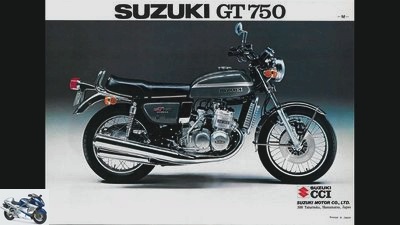
Andreas Issel
5/18
In Europe, the GT 750 was also offered in “Jewel Gray Metallic” in 1975, as this brochure shows. At the time, however, this colorway was a total flop.
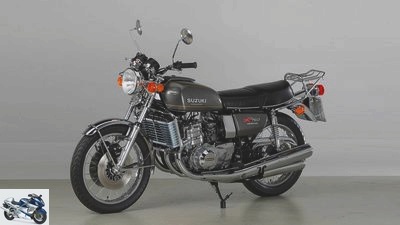
bilski-fotografie.de
6/18
Gray, gold and chrome: paint and rear fender in US design from 1976. The luggage rack is a reproduction of the original part.
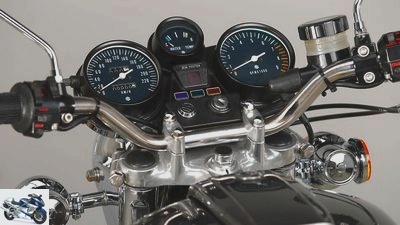
bilski-fotografie.de
7/18
Fresh again: The instruments in the clearly arranged cockpit have also been painstakingly restored by specialists.
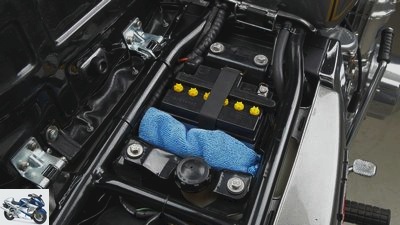
bilski-fotografie.de
8/18
Perfect down to the last detail: the refurbished base plate of the bench shines just as new as the paint on the frame.
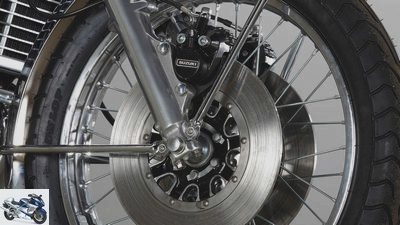
bilski-fotografie.de
9/18
More bite: brake calipers with steel braided brake lines.
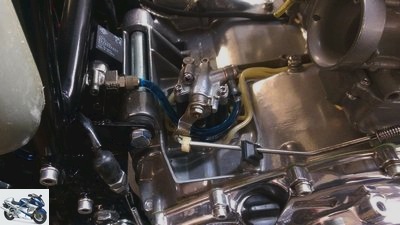
Andreas Issel
10/18
Less incontinence: electromagnetic shut-off valve for the oil.
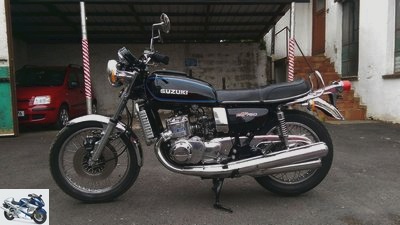
Andreas Issel
11/18
Suzuki GT 750 A in the studio.
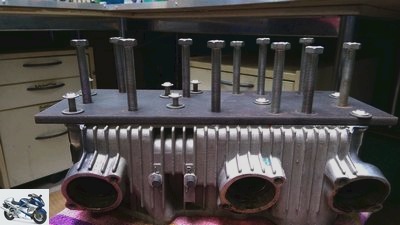
Andreas Issel
12/18
The cylinders could only be removed without damage using the special tools they had built themselves.
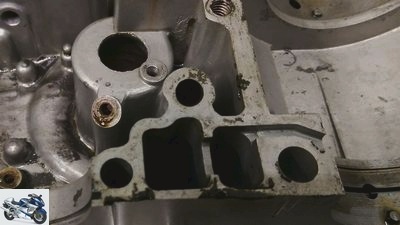
Andreas Issel
13/18
Casting errors ex works: The groove on the water channel for the O-ring was missing…
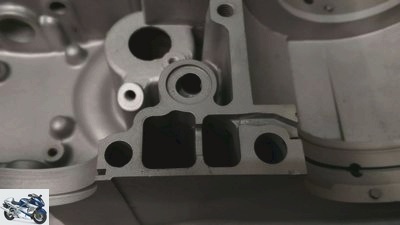
Andreas Issel
14/18
…It has to be like that.
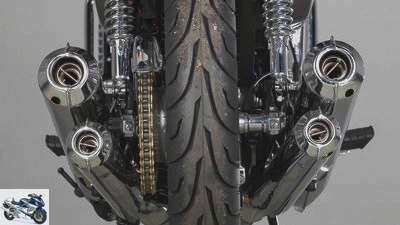
bilski-fotografie.de
15/18
Suzuki GT 750 A in the studio.
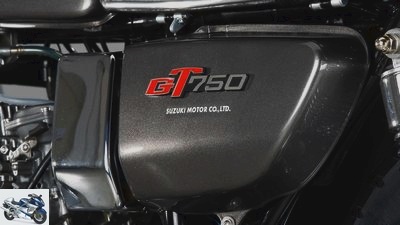
bilski-fotografie.de
16/18
Suzuki GT 750 A in the studio.
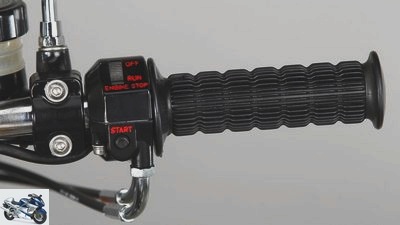
bilski-fotografie.de
17/18
Suzuki GT 750 A in the studio.
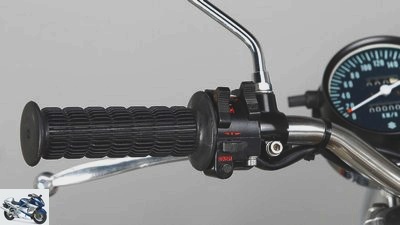
bilski-fotografie.de
18/18
Suzuki GT 750 A in the studio.
Suzuki GT 750 A in the studio
Water Buffalo in Jewel Gray Metallic
Content of
Only intimate connoisseurs of the Suzuki GT 750 know about the color “Jewel Gray Metallic” from model year 1975. In reality, however, hardly anyone has seen it. Even Suzuki expert Andreas Issel has never seen such a gray water buffalo. Until he started to rebuild.
A.Outside hui, inside ugh – Andreas Issel still shakes his head today when he remembers the original condition of our photo model. “That was a real blender. Like so many Suzuki GT 750s that came to us from the USA via Holland in Germany in recent years. ”Still looking quite neat on the outside, the Schweinfurt restoration experts were gripped with horror when he worked on the mechanics on behalf of a customer this “badly assembled machine” made, a B-model from 1977. “The engine was completely flooded with water.” The cause was a casting error in the factory! In the lower motor housing, there was no groove for the O-ring on a cooling water channel that runs through both motor housing halves. This did not go unnoticed during a previous “overhaul”, as evidenced by residues of sealing compound at this point. Just as little as the completely worn and leaky water pump, the dripping overflow of which was quickly closed with a stopper and plenty of sealing compound – it is hard to believe how outrageous it is when it comes to the fast euro!
For the quick euro: botch on a grand scale
A botch that had hit the buffalo heart tremendously. And Andreas brought a lot of work, even when removing the cylinders. The water in the engine block caused the corroded studs to “swell” so much that Andreas could only remove the cylinder bank without damaging it with his own special tool. The crankshaft presented itself in a deplorable condition, the overhaul of which Bernd Braun took care of in the tried and tested manner (www.crankup.de), while the sturdy gearbox survived the ominous water bath unscathed. With the blasting and subsequent high-gloss compression of the two halves of the housing, the rebuilding of the Suzuki GT 750 began, which, according to the client’s request, should “ultimately shine” like Andreas ’own (see MOTORRAD Classic 5/2016). As usual with his overhauls, Andreas replaced the original cylinder stud bolts with self-made V5A stainless steel during this restoration. The aluminum gearwheel also comes from our own production and will now reliably drive the completely overhauled water pump instead of the original plastic part for many years to come.
Carburetor battery looked bad
On the other hand, Andreas always purchases new pistons – here in the first oversize – from Suzuki’s serial supplier in Japan, “in an impressive quality with extremely low tolerances,” as he emphasizes with great admiration. He leaves the grinding and honing of the cylinders to the appropriate level to a neighboring specialist company. After all, work remains “Belmondo”, as the expert is nicknamed, with such a complete restoration: For example, grinding out the deep chatter marks in the clutch basket, which Andreas then gave a smooth polish and a needle bearing. The carburetor battery also looked “really bad”. This was also put into the slide grinding machine for 30 hours. After the high-gloss compression, he provided the mixture preparation with completely new nozzle assemblies and nozzles. In order to cure a frequent incontinence problem of the Suzuki GT 750, Andreas installed an electromagnetic shut-off valve between the oil tank and the oil pump, which only opens when the ignition is switched on. The mechanical valves on the engine block cannot permanently prevent the lubricant from leaking through the engine and exhaust.
The order was: “Make them gray for me!”
The usual routine was refurbishing the double-loop chassis: straightening the worn out mounts of the main stand, then stripping, priming and repainting the frame and adding new bearings. It goes without saying that the fork and brakes of the Suzuki GT 750 have also been completely overhauled. The struts are, however, true-to-original replicas from England that “work extremely well”. It is from there that Andreas also purchases the Delkevic exhaust system made of chrome-plated steel, which is also indistinguishable from the original. Otherwise, the customer had nothing to do with the series condition. Rather, the task was to turn the somewhat sober 1977 model into a shiny chrome A-model from 1976 during the reconstruction – in gray! What made Andreas wonder at first. He knew about the 1975 vintage “Jewel Gray Metallic”. But not that this color variant was still available in the USA in 1976. “It was a total flop for us, the bright candy colors were the main buyers back then.” He found the paint in England and fulfilled his customer’s request. The result: stunning! Not just because of the rare color. But because Andreas has once again managed to turn a mechanically desolate blender into a dazzling beauty!
Documentation for the restoration of the Suzuki GT 750
Externally, the Suzuki GT 750, a 1977 model, looked quite neat at first glance. However, with its malfunctioning technology, this US import also turned out to be a blender.
Water in the engine and transmission, the drain hole of the broken water pump that was fraudulently greased, a defective head gasket, a severely damaged crankshaft, worn pistons, heavily corroded cylinder studs, and, and, and – technically, this wildly pieced-together Suzuki GT 750 was in a downright miserable condition when Andreas Issel took care of him. All the more interesting is the detailed and richly illustrated documentation of all the mechanical defects and the restoration of our photo model, which “Belmondo” shows on its homepage. More about this at www.belmondos-bikeschmiede.de
Related articles
-
Suzuki GSX-S 1000 F in the 50,000 km endurance test
markus-jahn.com 46 photos Bilski 1/46 “Can you still handle 151 hp and 106 Newton meters? In any case, leave the traction control in, ”warns test boss…
-
Generation comparison Suzuki 1200-1250 Bandit
Generation comparison Suzuki 1200/1250 Bandit Glorious bandits Suzuki’s extremely successful large Bandit models are the prelude to a new …
-
Suzuki V-Strom 250 in the driving report
Suzuki 17 pictures Suzuki 1/17 Suzuki V-Strom 250.Suzuki 2/17 Suzuki V-Strom 250.Suzuki 3/17 Suzuki V-Strom 250.Suzuki 4/17 Suzuki V-Strom 250.Suzuki …
-
BMW R 100 CS (1983) in the studio
bilski-fotografie.de 13 pictures bilski-fotografie.de 1/13 Timeless, classic elegance: the BMW R 100 CS in the studio. bilski-fotografie.de 2/13 Boxers in …
-
On the move with Suzuki GT 750 and Suzuki GS 750
fact 37 pictures www.factstudio.de 1/37 With the GT 750 and GS 750, Suzuki had two attractive alternatives in its range, … www.factstudio.de 2/37 The cockpit …
-
Jahn 13 photos Suzuki 1/13 In black and yellow, the Gladius can compete with the Honda Hornet. Suzuki 2/13 The low seat belt was specially tailored to…
-
Suzuki GSX-R 750 and Yamaha FZ 750
Hartmann 15th photos Hartmann 1/15 For the 100th birthday of the motorcycle 30 years ago, the most beautiful gifts came from Japan: Suzuki’s GSX-R 750,…
-
Suzuki Gladius and Kawasaki ER-6n in comparison test
Blacksmith 16 photos Jahn 1/16 Suzuki Gladius and Kawasaki ER-6n in comparison test. Which of the 650 twin-cylinder has the edge in the end? Jahn 2/16…
-
Triumph Speed Triple S against Suzuki GSX-S 1000 in comparison test
Rivas 19 pictures Arturo Rivas 1/19 picture gallery: Triumph Speed Triple vs. Suzuki GSX-S 1000. Arturo Rivas 2/19 The popular biker greeting wins …
-
Top test of the Suzuki V-Strom 650 ABS
Bilski 13 pictures Bilski 1/13 Not just nicely styled. In touring trim, the handy Suzuki V-Strom tempts you to brisk down winding roads …